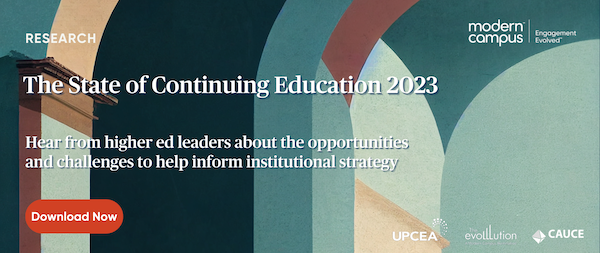Published on
Adopting Continuing Education Into the Institutional Strategy

Continuing Education units have typically sat outside the institution for decades. But as the modern learner emerges, CE units have been able to respond quickly and adapt to these learner needs, since this is a demographic they’ve been serving all this time. To move forward as one, CE needs to have a seat at the table when it comes to the institution’s overall strategy. In this interview, Fred Anger discusses the historic siloing of CE units, how his institution collaboratively works with CE and shares how to better leverage the of CE’s skills to achieve institutional success.
The EvoLLLution (Evo): Why have CE units historically been siloed?
Fred Anger (FA): CE units have historically been siloed because, most commonly, main campus and faculties are busy fulfilling their important mandates to provide a high-quality degree experience for full-time students, and CE is usually not a strategic focus for most universities. CE has traditionally been seen as night school or part of the university’s community outreach, rather than an integrated part of campus activities. Most CE units, at least in Canada, are expected to run their own courses, cover their expenses and return a small portion of excess funds to the university. Because CE units have largely been self-sustaining with their own administrative support and adjunct sessional contract lecturers, they often don’t see the importance of connections to main campus, nor does main campus view CE as a priority.
However, these thoughts really represent a generalized view of CE; not all CE units are siloed. At TMU, we have tried to be more integrated with the main university for a number of reasons. First, we have traditionally delivered over 80% degree credit courses within our certificate offerings. A collaborative relationship with faculty to ensure quality delivery has therefore been a key success factor at TMU. For over 85% of students in degree credit courses, we have utilized a complex integration of Destiny One into the TMU registration system, the system of record for degree students. Another important driver of integration has been the ever-evolving need to integrate more systems and processes to ensure institutional efficiency while adhering to cybersecurity and privacy standards. At TMU, our CE unit has been required to cover all of its expenses but has also generated a significant return to the university, which has contributed to strategic alignment. Our experience is that integration with main campus has several key benefits for both our CE unit and the university, raising CE’s profile within the university community.
Evo: What are some key qualities or skills that make a CE unit unique?
FA: Agility to respond quickly to changes in the adult learning market has always been a key success factor for CE units. Focusing on curriculum delivery that provides a pathway for learners to better realize their career goals is very important, especially with today’s learners focusing on their educational investments’ ROI. CE units are typically very innovative, trying out new types of curricula that may eventually become part of degrees and delivery modes to better align with student needs, and piloting new types of products like microcredentials. CE units also have an entrepreneurial focus that often doesn’t exist elsewhere in the university.
Evo: What are some challenges that come with CE units sitting outside the institutional strategy?
FA: CE units sitting outside the institutional strategy can lead to lack of alignment, siloing, poor communication and coordination (especially related to external business development), as well as duplicating resources that could be more efficiently shared. CE units may pursue strategies that do align or that conflict with the institution, which can result in the CE unit losing status and reputation within the university—all of which are bad outcomes. CE units left out of institutional strategy will rarely have a seat at important meetings and be left out—to their own detriment—when important strategic information is discussed. Finally, CE units that sit outside the institutional strategy will often struggle for senior leadership attention on important matters as well as funding challenges when budgets become tight.
Evo: What are some best practices to eliminate silos across campus?
FA: In my experience, the best way to eliminate silos is to engage with the rest of the university on matters of common interest to get a seat at the table for meetings that will foster cross-communication, engagement, feedback, and to build trust, which is essential for long-term success. CE leaders will position their units well by building effective relationships with key stakeholders across campus. Through this process, new ideas that provide growth opportunities for both CE and the rest of the university often arise. It’s also very important for leaders to encourage middle management in CE units to engage with their counterparts across the university, as this is often the source of key knowledge transfer that provides enormous operational benefits for the unit as well as the rest of the institution.
Evo: How can CE units leverage their uniqueness to better position the institution for success?
FA: I believe the key is to leverage CE units’ often unique ability to respond quickly to new and innovative growth and reputation-building opportunities, for which most of the rest of the institution would not have the appropriate resources, knowledge or interest to respond effectively for overall institutional success. To fulfill this role, the CE unit must build its reputation within the institution as a responsive team player with superior ability to execute when the initiative aligns correctly with its strategic mandate. CE units that can build up the institution’s reputation while filling gaps that otherwise would prevent institutional success on specific initiatives will be looked upon favourably by senior administration as responsive and successful. However, CE units that fail to build this internal reputation may be passed over on initiatives where they could play an important role in securing wins for the institution. Thus, this is all interrelated and goes back to the original question around siloed CE units. I truly believe an integrated CE unit, constantly working to build up the institution’s reputation and earn its trust, is a key success factor for both the unit and the university or college.

Author Perspective: Administrator



